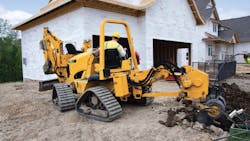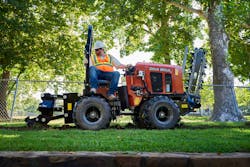Finish the infrastructure gap by choosing the right trencher
The push toward electric equipment will affect many things in a manager’s world, but perhaps one of the least thought of is the increasing underground placement of electric lines for the charging infrastructure.
In addition, the electrical grid will need to be “hardened” in places. Inevitably, some of that work will fall to trenchers.
“As utility companies work to build a more resilient electrical grid, there are several exciting opportunities opening up for contractors doing electrical installation work,” says Ed Savage, Vermeer product manager.
Trenchers will have "a significant role," Savage says. "Especially in rural areas where there are less existing underground utilities or a larger right of way to work in, there are limited above-ground obstacles like you would encounter in an urban area, or when a large-diameter trench is needed for more complicated installs.
"With the growth of the renewable energy market, there are a lot of work opportunities for electrical contractors," Savage says.
Even wind and solar farm operations need to be connected to the electrical grid to move their energy. And with more EVs on the road, more charging stations will be needed. “Fast-charging stations and the ability to charge several vehicles at one site often require larger electrical lines than what’s currently running to these sites,” Savage says. “So, this is another area where there is potential growth in the coming years.”
For fleets, not only does more electrical installation mean more opportunity, but it also means some will have to make a choice between using a trencher or a horizontal directional drill (HDD). And, depending on the flow of work and financial considerations, it may make business sense for a contractor to rent trenchers.
Check terrain before choosing a trencher
Both major underground OEMs, Ditch Witch and Vermeer, offer trenchers, HDDs, and different plow/trencher combinations. Selecting the proper machine can be a challenge, for electrical work and otherwise.
The location and surroundings of the job site are a big factor in selecting the right equipment.
According to Savage, urban environments are typically well-developed areas, creating numerous obstacles like roads, driveways, and buildings. These are all things contractors must navigate around for underground utility installation and makes trenchless installation an appealing method. Score one for HDDs.
“Using trenchless installation methods, like horizontal directional drilling, auger boring and piercing tools, tends to be more efficient than cutting through hard surfaces and then repairing them,” Savage says.
“Rural areas, however, have fewer road intersections and other obstacles to account for,” Savage says. “Trenching or using a vibratory plow in these areas is typically faster than using HDD alone.”
Trenching is also a preferred method when installing utilities in greenfield development projects. With pre-existing underground utilities being limited, there are not many obstacles to navigate around.
Another factor is utility bundle size and its installation depth.
“If a contractor is installing small-diameter electrical or fiber lines at a shallow depth in soft soil conditions, a vibratory plow is likely their best option,” Savage says.
Installing product in hard rock will require a higher-power machine.
“In rock and when installing large-diameter products at depths greater than 5 feet, contractors may consider using a higher horsepower trencher with a larger boom and chain configuration that allows them to cut a trench the required width,” Savage says.
Another consideration when deciding between HDD and trenching is equipment availability.
“Unlike directional drills, trenchers are typically available at rental stores,” Savage says. “Renting can be an attractive solution if the contractor only has a minimal amount of product to install.”
Is it better to buy or rent a trencher?
First-time users can have a difficult time with the buying versus renting decision.
Savage recommends using one or a combination of approaches as a viable strategy to maximize productivity, expand into a new market, or work on a wider variety of job sites.
“There are several factors to consider if you are thinking of renting a trencher,” he says. “The first is the frequency of use.”
Ask the following questions: Will this work be performed frequently or irregularly? Is the job long term or short term? Will a trencher be needed on future job sites?
“If you only need to utilize a trencher on occasion, renting may be a better option for your business,” Savage says. “This is because the cost to rent is likely less than the cost to buy and maintain your own trencher. Knowing if you will be using a trencher on job sites in the future will determine if renting or buying will make the most sense for your business.”
Contractors should also consider the size of the trench.
“For smaller jobs where you may only need to trench a few miles, it might make more sense to subcontract that job out or rent a machine,” Savage says.
Even contractors that already own a trencher can benefit from renting.
“It could be beneficial to rent an additional machine if you are working on a tight time frame and need to maximize productivity,” Savage explains. “Renting can also allow you to bid on jobs that may need a smaller or bigger trencher than what you have. Renting short term for a bigger job than what your current trencher is equipped for can be an effective way to gain experience and expand into a new market.”
Savage also wants managers to think about transportation.
“Before you transport your trencher long distances to complete a job, compare the cost of transportation and the cost to rent a machine closer to the job site,” Savage says. “Renting is a viable option even if you own a machine, and that is due to the location of the job site. For example, if you own a machine and primarily use it in Iowa, but have a job in Maine, it may be more economical to rent a trencher in Maine due to transportation costs. This can be a beneficial strategy to practice, especially if you are looking to expand your business in new locations.
Also, don’t forget about ground conditions in the new location. Renting a trencher locally will likely mean it is already equipped for the grounds in that location. The owned machine may not be properly configured—and it will have to be transported.
“An effective way to expand into different markets is to rent equipment, and gauge how it works with your business,” Savage says. “Try to look for the types of job sites the equipment fits and determine if this could be a long-term service you can offer.
“Also, if you are unsure of certain brands or models, renting a trencher can be a good way for your crew to test equipment on your job site,” Savage says. “Especially if you are located near a dealership that has multiple models available, this could be a great option for your crew to gain some experience with the machine and determine what would be the best fit. Once the crew is confident and comfortable with the brand or model, it may be worth investing in a trencher.”
How to keep trenchers working at peak performance
Keeping the investment productive for the lowest cost means keeping a close eye on the trencher’s performance parts—the chain, teeth, and sprockets (CTS).
“When faced with the cost of new digging equipment, contractors often look at the CTS system to extend the life of their equipment and get the highest ROI,” says Scott McKinley, digging systems product manager for Ditch Witch. “One of the most important items industry professionals can do to extend the life of their CTS components and maintain job site efficiency is to follow equipment best practices and be diligent with their maintenance routine.
“However, it’s not always easy to know when or what visual clues are indicative of equipment repairs,” McKinley says. “This is especially true as one part of the CTS system can often wear at a different rate than the others.”
Best practices and maintenance tips for a trencher’s CTS system include monitoring for wear, keying in on visual clues, addressing tooth issues immediately, monitoring chain tension, and matching teeth to ground conditions.
McKinley says that one of the most common causes of CTS wear and tear occurs when a system is forced to perform a task beyond what the machine is designed to do.
“Many contractors think that if the trencher’s engine starts, then the digging system is good to go,” he says. “But depending on where the equipment is being used, the CTS components need more frequent monitoring to maintain job site efficiency.
“It’s important to know the limitations of the machine and correctly match the CTS system to the conditions that they are digging in,” McKinley says. “Not properly outfitting the CTS system with the correct chain and teeth for the ground conditions can lead to increased wear and tear on the digging system and trencher unit—ultimately causing costly downtime."
What should contractors look for when inspecting their CTS components?
“One answer is an apple core,” McKinley says. “The main wear component on a digging system are the chain rollers. If the rollers start to look like an apple core, or if the pin is visible, then it’s time to replace it. Because the roller is the one component of the CTS system that is constantly used, operators should be sure to inspect it often.”
While looking at the rollers, McKinley says it is also important to inspect the sprockets. Sprockets are engineered to interact with the trencher chain to enhance the overall performance and wear life of all digging components.
“When the teeth on a sprocket start ‘thinning,’ it’s time for a replacement,” according to McKinley. “Customers should replace the head-shaft sprocket when replacing the digging chain. Not changing the sprocket will likely lead to premature wear on the new chain and will end up costing you more money.”
Keep trencher teeth sharp
Another indicator of CTS component wear and tear can be seen on the trencher’s teeth. McKinley says manufacturers often apply carbide to reinforce the strength of the teeth and extend the life of a machine. However, when that carbide begins to wear down to the base steel, the tooth becomes worn and risks breaking off.
“A worn-down tooth can negatively impact a machine’s efficiency,” McKinley say. “For example, when the front tooth begins to thin and it is not addressed, the other teeth are then forced to take more of the shock load and the brunt of the labor. This can prematurely wear out the other teeth and risk the loss of teeth altogether.
“As a best practice, contractors should either replace teeth that have worn down right away or replace all the teeth together,” McKinley says “This will help save time, money, and minimize additional tooth wear and tear.”
Chain tension plays an important role in how the machine operates. Improperly tensioned chains will lead to premature wear and will not perform as well.
“To prevent abnormal wear and tear on trencher chains, operators should ensure that the chain has the appropriate tension by regularly checking its fit. This will ultimately improve productivity and prevent any lost revenue from efficiency lags or downtime. The proper tension for a trencher chain can be found in the operator’s manual for the equipment,” McKinley says.
Chains are available in multiple sizes for a variety of different trenchers.
“When checking the tension, contractors should ensure the chain is not sagging or too tight,” McKinley explains. “If chains do begin to sag, they’ll vibrate the equipment and cause unnecessary wear; if chains are too tight, different wear patterns on the sprocket or sidebars will begin to appear. It’s important for contractors to keep in mind that larger trenchers require bigger chains that will require more sag than smaller equipment.”
Matching teeth to ground conditions is vital.
“Success is all about using the right tool for the job,” McKinley says. “For trenchers, that means knowing the correct tooth configuration for the kind of soil and ground conditions on the job site. Not only will this help extend the life of the trencher, but it will also keep operators efficient and profitable.
“For example, a cup tooth is the standard utility tooth for most soil conditions,” McKinley says. “It is designed for soft and medium-type soils and has a scooped shape. Due to natural wear and tear, cup teeth will often lose their hard surface. Signs of excessive wear are noticeable at the wider points of the teeth, and wear will begin to show into the body of the tooth. In cases of extreme wear, the tooth will shear off, drastically reducing productivity.”
Another tooth that plays an important role in digging is the shark tooth; it is designed to pick and break through harder soil.
“This [one] is ideal for operators trenching through rocky or frozen ground,” McKinley says. “However, it’s important for contractors to frequently check for fractures or chips in the teeth and replace them immediately to minimize equipment damage and downtime.”
If a job site is filled with rocky soil, an alligator tooth may be called for.
“It constantly rotates while in operation, meaning that the teeth chip away at different parts of the soil throughout the digging process,” McKinley says. “If contractors notice any teeth at a standstill, they should inspect the teeth immediately and replace as necessary. Regardless of soil conditions, it’s always best practice for contractors to consult their local dealer to help ensure they are set up for success.”
About the Author
Frank Raczon
Raczon’s writing career spans nearly 25 years, including magazine publishing and public relations work with some of the industry’s major equipment manufacturers. He has won numerous awards in his career, including nods from the Construction Writers Association, the Association of Equipment Manufacturers, and BtoB magazine. He is responsible for the magazine's Buying Files.


